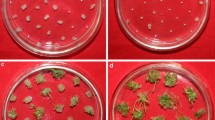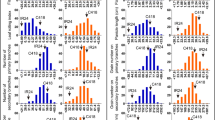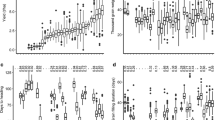Abstract
Quantitative trait loci (QTLs) that control the performance of tissue culture in rice were detected by using 116 RFLP markers and 183 BC1F3 lines derived from two varieties, Koshihikari and Kasalath. With time, the seed callus of Koshihikari tends to turn brown and stop growing, while that of Kasalath remains yellowish-white and proliferates continuously. The performance of tissue culture in the induction of calli from seed, the subculture of induced calli, and shoot regeneration were evaluated by five indices: induced-callus weight, induced-callus color, subcultured-callus volume, subcultured-callus color, and regeneration rate. Through callus induction and subculture, eight putative QTLs (P < 0.001) were located on chromosomes 1, 4, and 9. Among these QTLs, five Kasalath alleles and three Koshihikari alleles improved tissue culture performance. No QTL for regeneration was found. Among all the QTLs, qSv1 explained the largest phenotypic variance, 33%, in subcultured-callus volume. In induced-callus color, two detected QTLs accounted for 36.4% of the total phenotypic variance; this was the highest score among the five indices used to evaluate the performance of tissue culture. Three near-isogenic lines for QTLs, located in two regions on chromosome 1, were developed to evaluate their tissue culture performance. The Kasalath alleles in qSv1 and qSc1-1 improved callus color through callus induction and subculture, and increased the subcultured-callus volume and the fresh weight of regenerated calli, including shoots, roots, and differentiated structures. In qSc1-2, the Kasalath allele improved callus color through induction and subculture. These results verified the presence of QTLs for the volume and color of subcultured callus on chromosome 1, qSv1, qSc1-1, and qSc1-2.





Similar content being viewed by others
Abbreviations
- ICW:
-
Induced-callus weight
- ICC:
-
Induced-callus color
- SCV:
-
Subcultured-callus volume
- SCC:
-
Subcultured-callus color
References
Armstrong CL, Romero-Severson J, Hodges TK (1992) Improved tissue culture response of an elite maize inbred through backcross breeding, and identification of chromosomal regions important for regeneration by RFLP analysis. Theor Appl Genet 84:755–762
Ben Amer IM, Korzun V, Worland AJ, Borner A (1997) Genetic mapping of QTLs controlling tissue-culture response on chromosome 2B of wheat (Triticum aestivum L.) in relation to major genes and RFLP markers. Theor Appl Genet 94:1047–1052
Daigen M, Abe S (1993) Callus formation from seed explant, growth in suspension culture and plant regeneration in rice (Oryza sativa L. cv. Koshihikari). Plant Tissue Cult Lett 10:176–179
Daigen M, Kawakami O, Nagasawa Y (2000) Efficient anther culture method of the Japonica rice cultivar Koshihikari. Breed Sci 50:197–202
Kurata N, Nagamura Y, Yamamoto K, Harushima Y, Sue N, Wu J, Antonio BA, Shomura A, Shimizu T, Lin SY, Inoue T, Fukuda A, Shimano T, Kuboki Y, Toyama T, Miyamoto Y, Kirihara T, Hayasaka K, Miyao A, Monna L, Zhong HS, Tamura Y, Wang ZX, Momma T, Umehara Y, Yano M, Sasaki T, Minobe Y (1994) A 300 kilobase interval genetic map of rice including 883 expressed sequences. Nature Genet 8:365–372
Hashizume F, Tsuchiya T, Ugaki M, Niwa Y, Tachibana N, Kowyama Y (1999) Efficient Agrobacterium-mediated transformation and the usefulness of a synthetic GFP reporter gene in leading varieties of Japonica rice. Plant Biotech 16:397–401
Hiei Y, Ohta S, Komari T, Kumashiro T (1994) Efficient transformation of rice (Oryza sativa, L.) mediated by Agrobacterium and sequence analysis of the boundaries of the T-DNA. Plant J 6:271–282
Lincoln S, Daly M, Lander E (1992) Tutorial for MAPMAKER/QTL. In: Mapping genes controlling quantitative traits with MAPMAKER/QTL 1.1. Whitehead Institute Technical Report, 2nd edn. Cambridge, pp 7–42
Mano Y, Takahashi H, Sato K, Takeda K (1996) Mapping genes for callus growth and shoot regeneration in barley. Breed Sci 46:137–142
Mano Y, Komatsuda T (2002) Identification of QTLs controlling tissue-culture traits in barley (Hordeum vulgare L.). Theor Appl Genet 105:708–715
Shimamoto K, Terada R, Izawa T, Fujimoto H (1989) Fertile transgenic rice plants regenerated from transformed protoplasts. Nature 338:274–276
Ogawa T, Fukuoka H, Yano H, Ohkawa Y (1999) Relationships between nitrite reductase activity and genotype-dependent callus growth in rice cell cultures. Plant Cell Rep 18:576–581
SAS Institute (1989) The GLM procedure. In: SAS/STAT users guide, version 6, 4th edn. SAS Institute, Cary, pp 891–996
Taguchi-Shiobara F, Komatsuda T, Oka S (1997a) Comparison of two indices for evaluating regeneration ability in rice (Oryza sativa L.) through a diallel analysis. Theor Appl Genet 94:378–382
Taguchi-Shiobara F, Lin SY, Tanno K, Komatsuda T, Yano M, Sasaki T, Oka S (1997b) Mapping quantitative trait loci associated with regeneration ability of seed callus in rice, Oryza sativa L. Theor Appl Genet 95:828–833
Yamamoto T, Taguchi-Shiobara F, Ukai Y, Sasaki T, Yano M (2001) Mapping quantitative trait loci for days-to-heading, and culm, panicle and internode lengths in a BC1F3 population using an elite rice variety, Koshihikari, as the recurrent parent. Breed Sci 51:63–71
Yu K, Pauls K (1993) Identification of a RAPD marker associated with somatic embryogenesis in alfalfa. Plant Mol Biol 22:269–277
Acknowledgments
We thank Mr. Liew Yike Hwai (Tsukuba University) for his technical assistance in tissue culture. This work was supported by grants from the Ministry of Agriculture, Forestry, and Fisheries of Japan (Rice Genome Project) and the Sumitomo Foundation 2003.
Author information
Authors and Affiliations
Corresponding author
Additional information
Communicated by Q. Zhang
Rights and permissions
About this article
Cite this article
Taguchi-Shiobara, F., Yamamoto, T., Yano, M. et al. Mapping QTLs that control the performance of rice tissue culture and evaluation of derived near-isogenic lines. Theor Appl Genet 112, 968–976 (2006). https://doi.org/10.1007/s00122-005-0200-3
Received:
Accepted:
Published:
Issue Date:
DOI: https://doi.org/10.1007/s00122-005-0200-3




